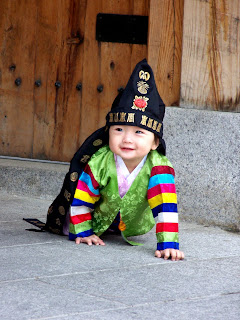The Total Animal Soup of Time, Part II
Somehow the semester is nearly done.
Just yesterday I was wondering how to introduce "Howl" to students I did not know, who had no frame of reference for what I hoped to teach and brought unknown expectations of their foreign professor. I was also wondering how well my new students would read English and understand my rapid-fire lectures.
Now we are finishing our last books and thinking about the final assessment.
On the first day of classes I worked hard to discover what my expectations should be so that I could attempt to bridge the gaps. That first day the classes were quite big -- not the hundred I might have had in one classroom, but big enough. More significantly, I had no solution to the problem of getting affordable books in English, so my reading lists were tentative. I needed quite a bit of specific information quickly, but I was not sure how to get it.
Getting Korean students to talk, as a general rule, is quite difficult; most of them are accustomed to sitting without speaking in the classroom.The general idea is that the teacher lectures and students take notes. It is, I suppose, flattering to think that I might have so much valuable information stored up. But all the same I prefer give and take. My internal GPS functions on eye contact and body language, both of which Korean students have learned to keep under control.
By the second week, the classes were smaller. I think some students, who were initially curious about the foreign professor, felt the work would be too hard or that there would be too much reading in English. Some may have found the prospect of facing me every week to be a bit daunting. Perhaps it is true that I am intimidating, although the notion always strikes me as misplaced.
I was sorry to lose so many right off because I have been excited about the learning opportunities. My learning opportunities, that is.
Whatever the reasons, it has been better with smaller classes -- fourteen in the undergraduate class on immigrant literature and nine in the graduate class on the literature of rebellion. We have, at least in the graduate class, reached a point where interaction during class is common and fairly easy. I do not exactly teach through discussion, as is my preference, but we come close.

It is the graduate class where we used "Howl" as our first reading. That was a bit of chutzpah on my part, I suppose, but the choice actually worked well. We spent a lot of time on "Howl."
It was not so much the objectionable stuff that concerned my students -- or me, after my initial what-have-I done! Every language has its dirty words and every culture has its provocative behaviors, so these elements were not an obstacle to learning. In fact, these things are part of a fabric of puzzling references and allusions that needed context and explanation, and the form of the poem can be dizzying. All of this meant I had to approach the poem by explaining context and form.
As Ginsberg graphically parades nearly every major American concern of the 1950s, I was free to discuss the historical circumstances that made the literature of rebellion necessary. As he speaks the unspeakable and reveals the hidden, we were in open territory. In the process, the poem begins to make a great deal of sense. It becomes a map of the post-war American subconscious.
The undergraduate class has proven a different sort of challenge. Part of that challenge is due to the size of the room; there are fifteen of us in a lecture hall with 100 seats and with a raised stage for the professor. What this has meant is that the natural gaps are emphasized. It is more difficult to create the atmosphere of familiarity in which a Korean student might be encouraged to look up and, dare I think it, speak.
Now, as I have said, the semester is nearly gone. We have reached the "end game" in both classes. How shall we draw our studies to satisfactory conclusions?
In the Immigrant class we have finished our books and have begun what I call "ruining movies." We are watching The Joy Luck Club together over a period of three classes with suitable time before and after the segments for discussion. I am ruining this movie for my class both because the story is ideal for our topic and because it gives them time to write their final paper without the pressure of new reading for class.
The graduate class came over for lunch this week to see how the foreign professor lives, to meet his wife, and to enjoy a taste of American hospitality. We had a good time. We have reached a good point in this learning experience.
Too bad we are reaching the end. If only we had world enough and time.







































